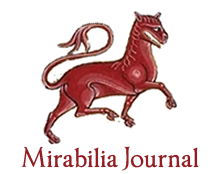Images of the body in the rhetorical ethos of Cicero (106-43 a. C.) and Descartes (1596-1650)
Giannina BURLANDO
Original title: Imágenes del cuerpo en el ethos retórico de Cicerón (106-43 a. C.) y Descartes (1596-1650)
Published in The Medieval Aesthetics
Keywords: Body images, Cicero, Descartes, Rhetoric.
The main hypothesis of the study tries to establish that there are images of bodies, which play the role of figuring a certain rhetorical ethos in both Cicero and Descartes. Both are critical authors of the rhetoric inherited from their predecessors, who in turn build their new rhetorical ethos. The first section shows a rhetorical ethos permeated by images of neo-academicist bodies of the mythical-epic type that mirror the vital culture of Cicero. The second to the fifth section includes the perspective and images of neo-Renaissance mathematical-geometric bodies in the work of Descartes, in both cases, the images of bodies have sign value of their times.
Imagining Otherness: The Pleasure of Curiosity in the Middle Ages
Anna KOŁOS
Published in Pleasure in the Middle Ages
Keywords: Augustine of Hippo, Curiosity, Imagination, Order of things, Otherness, Pleasure.
The main aim of this paper is to take a closer look at both the philosophical and religious presumptions upon which the medieval concept of curiosity was premised. Such an enterprise needs to go back to Aristotle in order to fully comprehend the limitations for curiosity introduced by St. Augustine in his City of God and developed by such medieval thinkers as Isidore of Seville and Thomas of Aquinas. These conceptions will be analysed in reference to Foucauldian archeology of knowledge. Much attention should be paid to the ideas of curiositas, admiratio and studiositas.
Interdisciplinary reflections on German and Latin Medievistics (X-XI centuries)
Álvaro Alfredo BRAGANÇA JÚNIOR
Published in The World of Tradition
Keywords: Charms, Germanic philology, Medieval Latin, Medieval Latin Paremiology, Medievistics, Old High German Literature.
The Middle Ages, in a long-term perspective, opens to different epistemological approaches from distinct fields of knowledge. Within the Brazilian academic scenario, the predilection for models of historiographical and literary analysis based on French, Anglo-American, Italian, Spanish and Portuguese theoretical and methodological assumptions is understood for linguistic and historical reasons in the development of medieval studies in Brazil. With this statement in mind and with the aim of expanding access to other historiographies, in this article, after an introduction based on the medieval or medievalistic binomial, we conceived a brief discussion on the medieval studies of German and Latin literature in the 10th and 11th centuries with the reflective focus on Der zweite Merseburger Zauberspruch in Old High German and Medieval Latin paremiologically expressions.
Interior decoration of lay public spaces in the Middle Ages
Jesús CANTERA MONTENEGRO, Ángela ORGANERO MANZANERO
Original title: Decoración de interiores públicos laicos en la Edad Media
Published in
Keywords: Ambrogio Lorenzetti, European painting, Fiscal system, Florence and Siena, Political propaganda.
The secular presence on art during XIV century, reflects how artistics genres started a process of indipenditation of eclesiastic world. In Europe, in this age a fiscal system was stablished that aloud a fluence transmission of money to coffers. This made Florence and Siena gain a strong economic stability. With the total control of middle class, took place the building of Public Palace of Siena and the decoration of the Sala dei Nove by Ambrogio Lorenzetti. This frescos constitutes a unicum european painting because his conception and convey feelings, like one of famous manifiestion of political propaganda of Middle Age. Ambrogio, under allegorical, political, theological and philosophical pressure, put together a whole political ideology result of agreement between citizens.
Interreligious Dialogue before and after Nicholas of Cusa: an Exegetical Approach
Marica COSTIGLIOLO
Original title: Interreligious Dialogue before and after Nicholas of Cusa: an Exegetical Approach
Published in Nicholas of Cusa in Dialogue
Keywords: Exegesis, Hermeneutic, Interreligious Dialogue, Nicholas of Cusa, Rites.
In this article my aim is a philosophical reflection on a history of interreligious dialogue from the perspective of the dialectical relation between rites of different religions: given that rite is one of the most essential aspects of religions, it should be profitable to examine the significance of rites in light of interreligious dialogue. First, I will explain some theories about religions' difference. I will analyse texts written by Christian and Jewish authors from the Middle Ages to the Modern period in order to compare the crucial role of rite in philosophical and religious discourse among different chronological and cultural panoramas. Among the authors who wrote outstanding works focused on the relations between Islam and Christendom, I wish to mention in particular Nicholas of Cusa, who wrote the De pace fidei, one of the most famous interreligious dialogue in the Middle Ages. The following paragraph of my article is on a 12th century Jewish scholar, Judah Halevi, who wrote the book Kitab al Khazari (Sefer ha-Kuzari, in Hebrew), which is considered one of the most polemical and well-known medieval works and a source of Ramon Llull (1235-1315), the most relevant source of the De pace fidei. The second paragraph is on Aberlard, who, like Cusanus, wrote his Dialogus inter philosophum, Judaeum et Christianum in a period of conflicts and violence. Like De pace fidei Abelard’s dialogue is a work of the author’s maturity which deals with the theme of rational and intellectual knowledge as an instrument of confrontation between different confessions. I will analyse the theme of rites in this Abelard's work. I will also take a look of the work of Lessing, to highlight the fundamental role of transmission of traditions and rites for the construction of a specific religious identity.
Introduction to Medicine didactics of the Middle-Ages: analysis of medical treatises of the Iberian Peninsula
Josué VILLA PRIETO
Original title: Introducción a la didáctica de la Medicina en la Edad Media: análisis de los tratados médicos de la Península Ibérica
Published in
Keywords: Alonso Chirino, Arnau de Vilanova, Didactic treatises, History of Education, History of Medicine, Medieval medicine, Ramón Llull.
The Medical treatises produced in the Iberian Peninsula express Galen and Hippocrates traditional knowledge almost without introducing something new until the Late Middle Ages. This study proposes an interpretative synthesis about those new elements in a significant period of the genesis of Medicine as a modern science: how intellectuals define their attributions, how is inserted its teaching at Iberian studia generalia, who compose textbooks and materials for its study, how are organized these same treatises and, of course, which contents do they have.
Isabel de Villena, a very special and feminine theological look
Lola ESTEVA DE LLOBET
Original title: Isabel de Villena, una mirada teológica en femenino muy singular
Published in Isabel de Villena (1430-1490)
Keywords: Coadjuvants women, Redemption, Trinity theologie.
The traditional reception from on of the classical works referents of European spirituality, el Vita Christi, by Ludolf de Sajonia, hass been transformed by the writings of Isabel de Villena, who in her book, la Vita Christi, offers a new point of view, human and humanistic at the same time: the life of Christ develops in a theological threatsense of trinity experience where women at as adjuvant of Christ Redemption.
Isabel de Villena: Prayer and Franciscan Spirituality
Lesley K TWOMEY
Published in Isabel de Villena (1430-1490)
Keywords: Franciscan prayer techniques, Franciscanism, Middle Ages, Orality, Passion.
This essay examines traces of the oral in the prayers written by Isabel de Villena (1430-1490), abbess of the Santa Trinitat convent in Valencia. The essay compares the prayers of Christ in the Garden of Gethsemane in the Vita Christi with St Francis’s Office of the Passion. It finds that whilst there are some similarities between St Francis’s Office and Villena’s Vita Christi, this is because of technique in using phrases from the Psalms rather than direct influence.
Itaque sine musica nulla disciplina potest esse perfecta: musical iconography in hispanic romanic sculpture
Alicia MANSO SAN ISIDRO
Original title: Itaque sine musica nulla disciplina potest esse perfecta: la iconografía musical en la escultura románica hispana
Published in Music in Antiquity, Middle Ages & Renaissance
Keywords: Instruments, King David, Last Judgement, Middle Ages, Minstrels, Music, Romanesque sculpture.
The presence of musical iconography in medieval art, particularly in Romanesque sculpture, is enormous. Thus, in this article we will focus on the chronology from the 11th to the 13th century, analyzing the most important examples on the most representented topics: the Final Judgement, King David, and profane scenes. Musical instruments are represented in both non-religious and religious scenes, included as a reflection of biblical texts with a profound theological content. Analyzing the representation of instruments gives us information about iconographic influences, that begin with the miniatures in the Beatos. Moreover, this analysis is useful regarding organology and musicology, assessing the verisimilitude of these representations with a multidisciplinar methology.
Jewish philosophical thought in al-Andalus
Cecilia Cintra Cavaleiro de MACEDO
Original title: O Pensamento filosófico judaico em al-Andalus
Published in Medieval and Early Modern Iberian Peninsula Cultural History
Keywords: Ibn Gabirol, Maimonides, Sefarad.
Initiated by Philo of Alexandria at the 1st century of Christian Age in dialogue with Hellenistic thought, philosophy was developed among the Jewish during the Middle Age in territories under Islamic political power and for many centuries it was written in Arabic. Hebrew was a language used for prayer, and for centuries, it did not have appropriate words to translate the concepts of Greek philosophy. For this reason, until the 13th century Jewish philosophy was written almost exclusively in Arabic. It migrated from Orient to Occident and, especially in al-Andalus, it had a very expressive development, through the efforts of the Caliphate of Cordoba and in the next period too, with the support of some of the separate kingdoms (Tawâ’if).






















































































